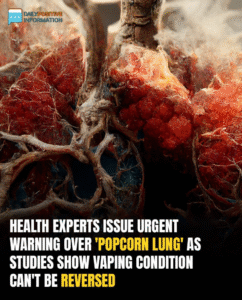Urgent Alert: Vaping-Linked ‘Popcorn Lung’ Causes Lasting Harm, Experts Say
Health experts are raising the alarm once again about a serious and potentially irreversible condition known as “popcorn lung”—a disease now increasingly linked to vaping. Though many people still believe e-cigarettes are a safer alternative to traditional smoking, new evidence suggests they may carry risks that are just as dangerous, especially when it comes to long-term lung damage.
Popcorn lung, medically known as bronchiolitis obliterans, is a rare but severe condition that damages the smallest airways in the lungs. This scarring and inflammation narrow the airways, making it difficult for oxygen to move freely through the body. Symptoms include a persistent dry cough, wheezing, shortness of breath, and fatigue—often mistaken for asthma or a minor respiratory infection in its early stages.
The condition got its nickname in the early 2000s after workers at a microwave popcorn factory developed it from inhaling diacetyl, a buttery-flavored chemical used in popcorn flavoring. Shockingly, this same chemical has been found in some flavored vape liquids—even those labeled as “safe” or “natural.”
While many manufacturers have since removed diacetyl from their formulas, not all have. The lack of consistent regulation means consumers often don’t know exactly what they’re inhaling. More troubling still, research shows that the heating process used in e-cigarettes can produce other harmful chemicals, including formaldehyde and acetaldehyde, both known to damage lung tissue over time.
Dr. Lisa Monroe, a pulmonologist at a major U.S. medical center, warns, “We’re seeing young patients with lung issues that used to take decades of smoking to develop. Vaping isn’t harmless—it’s just a different method of exposure to dangerous substances.”
The long-term risks of vaping are still being studied, but early evidence shows a pattern: inflammation, damage to lung linings, and in some cases, permanent reduction in lung function. Because popcorn lung has no cure, treatment focuses only on managing symptoms with steroids or inhalers—often with limited success.
Young people are especially at risk. The rise of flavored vapes and sleek, easy-to-hide devices has led to a dramatic increase in teenage vaping. Many believe they’re just inhaling flavored mist, unaware that one pod can contain as much nicotine as a pack of cigarettes, along with other lung-damaging chemicals.
Despite growing awareness, some users continue because of addiction or a false sense of safety. Public health campaigns are now focusing not just on quitting, but on education—making sure people understand that just because something is marketed as “smoke-free” doesn’t mean it’s safe.
In conclusion, popcorn lung may sound like a strange term, but its effects are devastating and very real. Vaping has opened a new path to respiratory harm, especially among the young. The best way to prevent popcorn lung and other vaping-related diseases? Avoid inhaling unknown chemicals into your lungs altogether.
